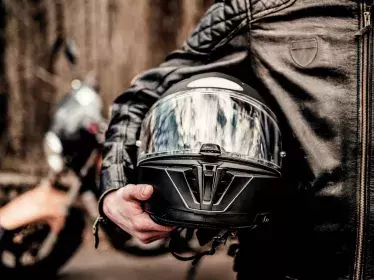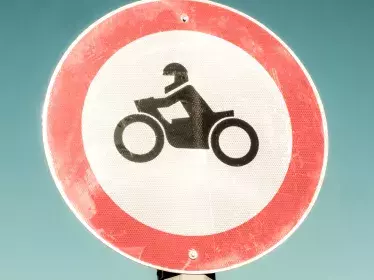1. Use the right motorcycle with suitable equipment
- Choose a motorcycle that suits your level of experience. Make sure that everything is in order (brakes, tyre pressure, levels) and wear suitable motorcycle equipment.
P - WYSIWYG - Alignment Left
2. See and be seen
- Choose equipment and a helmet that are coloured and can be seen, or that have reflective strips.
- Take note of the fact that there will be blind spots in the mirrors on cars and trucks in particular. Do not remain in the same place, next to or behind another vehicle for too long.
- Look out for other road users in their rear view mirrors to make sure they have seen you.
- Use your indicators to let people know what you are planning to do.
- Position yourself two-thirds towards the left in a traffic lane so that you can better observe traffic and the road and so that you can signal to car drivers in accordance with the highway code.
P - WYSIWYG - Alignment Left
3. Keep safety distances
- Keep your distance so that you can anticipate hazards.
- At 90 km/h, it will take 85 m to come to a complete stop in dry weather, including your reaction time. In wet conditions, this stopping distance becomes even longer.
- When riding past parked vehicles make sure to leave some space – the width of a door if possible. The ideal distance to leave is 1.50 m.
P - WYSIWYG - Alignment Left
4. Anticipate
- Look ahead of you as far as possible and look around you as widely as possible so that you can anticipate dangers and when you might need to brake (roundabouts, entrances and exits on corners, pedestrian crossings, traffic lights, potholes and other issues on the road, etc.).
- In an emergency situation, look where you want to go, not at the obstacle. The human brain works in such a way that where you look, is where you end up going. This is called target fixation.
- Pay attention to any vehicles that are following you (will they have time and room to brake?).
- Be aware of other road users and pedestrians, especially near pedestrian crossings. They may be surprised at how fast you reach them because of how fast your bike can accelerate.
- Two-wheeled vehicles are often smaller in size than other road users. It's important to understand that half of all motorcycle accidents are caused by motorists who did not notice a motorcycle early enough.
P - WYSIWYG - Alignment Left
5. Stay safe in queues
- Adjust your speed when you ride past a queue of slow traffic. Make sure that the speed difference between yourself and the queuing cars is no more than approximately 20 km/h. Get back into a lane as soon as the traffic is flowing again (from 50 km/h).
- Remember that some drivers tend to change lanes abruptly if a space suddenly becomes available or they get distracted when driving (using their mobile phone, reading the newspaper, etc.). Be on your guard!
- Particularly in summer, you need to be aware that people might suddenly open their car door if they are stationary in a queue.
P - WYSIWYG - Alignment Left
6. Only take to the road if you're feeling on top form
- Driving a motorcycle requires more physical effort and concentration than driving a car. Do not ride if you're tired or under the influence of alcohol, drugs or any medication that might cause you to be less alert.
P - WYSIWYG - Alignment Left
7. Adjust your speed
- Always adjust your speed so that you can react to unforeseen obstacles without putting yourself in danger.
- You should also adjust your speed if there is bad weather. Rain reduces visibility and reduces grip. Wind can cause you to deviate from your course and fog prevents you from seeing but also from being seen.
P - WYSIWYG - Alignment Left
8. Control your braking
- Find the right balance between the front brake (most effective) and the rear brake (slowing down and stabilising).
- Ideally, you should only brake when the motorcycle is travelling in a straight line. Slow down before turning and do not brake in the turn.
- Look far ahead into the distance when braking.
P - WYSIWYG - Alignment Left
9. Mitigate group-related risks
- Don't exceed your limits just to follow the group or encourage a less experienced rider to do so.
- Position yourself so that you are staggered.
- Keep a safe distance.
- Warn your fellow riders of possible danger.
P - WYSIWYG - Alignment Left
10. Pay attention to loads
- Whether it's a passenger or luggage, the weight and volume change the behaviour of your motorcycle: they move the centre of gravity, increase the braking distance and result in a greater wind load.
- Reduce your speed and increase safety distances, hold the handlebar more firmly, take safer routes, check the tyre pressures and adjust the suspension if possible.
P - WYSIWYG - Alignment Left






